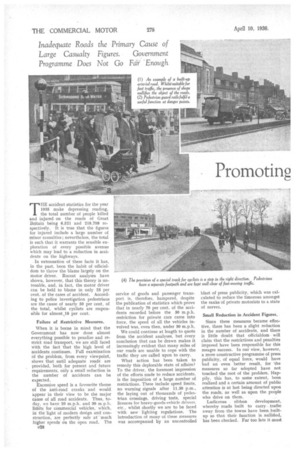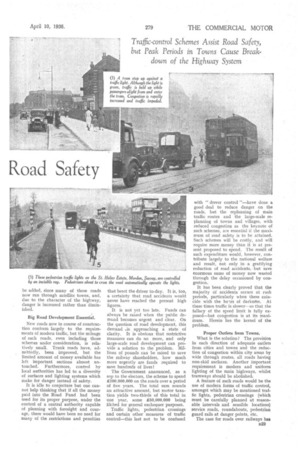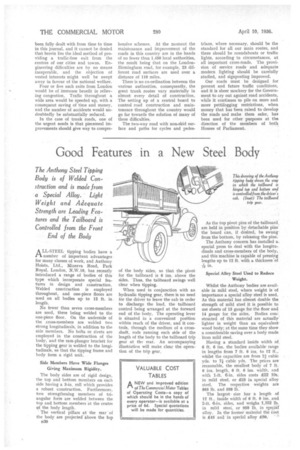Promoting
Page 42

Page 43

Page 44

If you've noticed an error in this article please click here to report it so we can fix it.
THE accident statistics for the year 1935 make depressing reading, the total number of people killed and injured on the roads of Great Britain being 6,521 and 218,798 respectively. It is true that the figures for injured include a large number of minor casualties; nevertheless, the total is such that it warrants the sensible exploration of every possible avenue which may lead to a reduction in accidents on the highways.
In extenuation of these facts it has, in the past, been the habit of officialdom to throw the blame largely on the motor driver. Recent analyses have shown, however, that this theory is untenable, and, in fact, the motor driver can be held to blame in only 25 per cent, of the cases of accident. According to police investigation pedestrians are the cause of nearly 50 per cent, of the total, whilst cyclists are responsible for almost 16 per cent.
Failure of Restrictive Measures.
When it is borne in mind that the Government has now done almost everything possible to penalize and restrict road transport, we are still faced with the fact that the high level of accidents continues. Full examination of the problem, from every viewpoint, shows that until adequate roads are provided, both. for present and future requirements, only a small reduction in the number of accidents can be expected.
Excessive speed is a favourite theme of the anti-road cranks and would appear in their view to be the major cause of all road accidents. Thus, today, we have 20 m.p.h. and 30 m.p.h. limits for commercial vehicles, which, in the light of modern design and construction, are perfectly safe at' much higher speeds on the open road. The
B28 service of goods and passenger transport is, therefore, hampered, despite the publication of statistics which prove that in nearly 70 per cent, of the accidents recorded before the 90 m.p.h. restriction for private cars came into force, the speed of all the vehicles involved Was, even then, under 90 m.p.h.
We could continue at length to quote from the accident analyses, but every conclusion that can be drawn makes it increasingly evident that many miles of our roads are unable to cope with the traffic they are called upon to carry.
What action has been taken to remedy this deplorable state of affairs? To the driver, the foremost impression of the efforts made to reduce accidents, is the imposition of a large number of restrictions. These include speed limits, no warning signals after 11.30 p.m., the laying out of thousands of pedestrian crossings, driving tests, special licences for heavy-goods-vehicle drivers, etc., whilst shortly we are to be faced with new lighting regulations. The introduction of many of these measures was accompanied by an uncontrolled
blast of press publicity, which was calculated to reduce the timorous amongst the ranks of private motorists to a state of nerves.
Small Reduction in Accident Figures.
Since these measures became effective, there has been a slight reduction in the number of accidents, and there is little doubt that officialdom will claim that the restrictions and penalties imposed have been responsible for this meagre success. In our view, however, a more constructive programme of press publicity, of equal force, would have had an even better result, for the measures so far adopted have not touched the root of the problem. Happily, this has, to some extent, been realized and a certain amount of public attention is at last being directed upon the roads, as well as upon the people who drive on them.
Ludicrous . ribbon development, whereby roads built to carry traffic away from the towns have been.huiltup so that their function is .nullified, has been checked. Far too late it must
be added, since many of these roads now run through satellite towns, and, due to the character of the highway, danger is increased rather than diminished.
Big Road Development Essential.
New roads now in course of construction conform largely to the requirements of modern traffic, but the mileage of such roads, even including those schemes under consideration, is relatively small. Trunk roads have, admittedly, been improved, but the limited amount of money available has left important sections almost untouched. Furthermore, control by local authorities has led to a diversity of surfaces and lighting systems which make for danger instead of safety.
It is idle to conjecture but one cannot help thinking that if all the money paid into the Road Fund had been used for its proper purpose, under the control of a central authority capable of planning with foresight and courage, there would have been no need for many of the restrictions and penalties that beset the driver to-day. It is, too, a certainty that road accidents would never have reached the present high figures.
It is not yet too late. Funds can always be raised when the public demand becomes urgent and clear. On the question of road development, this demand .is approaching a state of clarity. It is obvious that restrictive measures can do no more, and only large-scale road development can provide a solution to the problem. Millions of pounds can be raised to save the railway shareholders, how much more urgently are funds required to save hundreds of lives!
The Government announced, as a sop to the electors, the scheme to spend £100,000,000 on the roads over a period of five years. The total sum sounds an attractive amount, but motor taxation yields two-thirds of this total in one year, some £50,000,000 being filched for general exchequer purposes.
Traffic lights, pedestrian crossings and certain other measures of traffic control—this list not to be confused
with " dnver control "—have done a good deal to reduce danger on the roads, but the replanning of main traffic routes and the large-scale replanning of towns and villages, with reduced congestion as the keynote of such schemes, are essential if the maximum of road safety is to be attained. Such schemes will be costly, and will require more money than it is at present proposed to spend. The result of such expenditure would, however, contribute largely to the national welfare and result, not only in .a gratifying reduction of road accidents, but save enormous sums of money now wasted through the delay occasioned by congestion.
It has been clearly proved that the majority of accidents occurs at rush periods, particularly when these coincide with the hors of darkntess. At these times traffic is slower—so that the fallacy of the speed limit is fully exposed—but congestion is at its maximum. Herein lies the kernel of the problem, Proper Outlets from Towns.
What is the solution? The provision in each direction of adequate outlets from cities and towns and the reduction of congestion within city areas by wide through routes, all roads having non-skid surfaces. Another important requirement is modern and uniform lighting of the main highways, whilst tramways should be abolished.
A feature of such roads would be the use of modern forms of traffic control, amongst which may be mentioned traffic lights, pedestrian crossings (which must be carefully planned at reasonable intervals and sensible locations) service roads, roundabouts, pedestrian guard rails at danger points, etc.
The case for roads over railways has B29 been fully dealt with from time to time in this journal, and it cannot be denied that herein lies the ideal method of providing a traffic-free exit from the centres of our cities and towns. Engineering difficulties are by no means insuperable, and the objection of vested interests might well be swept away in favour of the national welfare.
Four or five such exits from London would be of immense benefit in relieving congestion. Traffic throughout a wide area would be speeded up, with a consequent saving of time and money, and the number of accidents would undoubtedly be substantially reduced.
In the case of trunk roads, one of the urgent needs is that piecemeal improvements should give way to compre
hensive schemes. At the moment the maintenance and improvement of the roads in this country are in the hands of no fewer than 1,450 local authorities, the result being that on the LondonBirmingham road, for example, 23 different road surfaces are used over a distance of 110 miles.
There is no co-ordination between the various authorities. consequently, the great trunk routes vary materially in almost every detail of construction. The setting up of a central board to control road construction and maintenance throughout the country would go far towards the solution of many of these difficulties.
The two-way road with non-skid surface and paths for cycles and pedes
trians, where necessary, should be the standard for all our main routes, and there should be roundabouts or traffic lights, according to circumstances, at all important cross-roads. The provision of service roads and adequate modern lighting should be carefully studied, and signposting improved.
Our roads must be designed for present and future traffic conditions, and it is sheer mockery for the Government to cry out against road accidents, while it continues to pile on more and more pettifogging restrictions, when money that has been raised to develop the roads and make them safer, has been used for other purposes at the direction a the members of both Houses of Parliament.




















































































